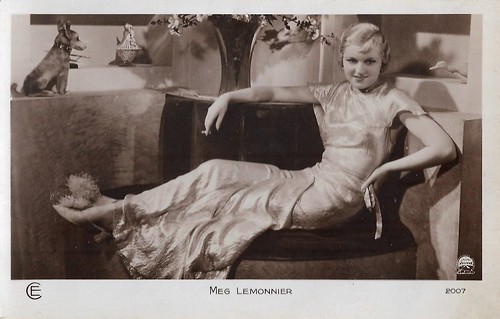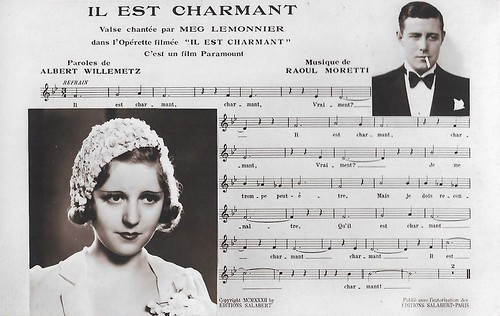Actress and singer Meg Lemonnier (1905-1988) was most active in the French cinema of the 1930s. In the early years of the sound film, she played more or less saucy ingénues in romantic comedies and operettas, often accompanied by Henri Garat.

French postcard by EDUG, no. 1010. Photo: Paramount.

French postcard by Cinémagazine-Edition, Paris, no. 2007. Photo: Paramount.

French postcard by E.C., no. 1001. Photo: Paramount. Collection: Didier Hanson.

French postcard by P-C, Paris, no. 4. Photo: Paramount. Meg Lemonnier sang the waltz 'Il est charmant' in Il est charmant (Louis Mercanton, 1932), also with Henri Garat. text by Albert Willemetz, and music by Raoul Moretti. Copyright: Editions Salabert, Paris, 1932.

French postcard by EC (Éditions Chantal), Paris, no. 55. Photo: Paramount. With Henri Garat.
Meg Lemonnier was born Marguerite Gabrielle Clarté (or Clark) in London, U.K., in 1905. She made her stage debut in 1928 and moved almost immediately to operetta in 1929. She performed in the French version of the operetta 'Good News' (1929).
Together with René Koval and Jean Gabin, she passionately sang in 'Arsène Lupin banquier' (Arsene Lupin banker), an operetta by Yves Mirande, Albert Willemetz and Marcel Lattès, which was created in Paris in 1930.
Other stage operettas were 'Les Aventures du Roi Pausole' (1930), 'Il est charmant' (1932), 'La Pouponnière' (1932) and 'Un soir de réveillon' (1932).
In the early days of the talking pictures, she made her film debut in Mon gosse de père/My Kid of a Farther (Jean de Limur, 1930). It was the period of the multilinguals and this was an alternate language version of The Parisian (Jean de Limur, 1931), both featuring Hollywood star Adolphe Menjou. In the following years, Lemonnier nicely played more or less saucy ingénues in mostly romantic comedies and film operettas.
She accompanied the popular jeune premier Henri Garat in many of his successes produced at Paramount, such as the filmed versions of Il est charmant/He is Charming (Louis Mercanton, 1932) and Un soir de réveillon/Christmas Eve (Karl Anton, 1933), also with Arletty. Lemmonier sang the hit 'Être une poule' (Being a Tart) in Un soir de réveillon. Like in most of her films, the story was quite flimsy: a modest girl meets a rich gentleman who circles in the demi-monde and thinks she is part of that as well. On Christmas Eve, she passes the night with him, and of course, the flirt becomes serious. The film revels in art deco interior design.

French postcard by A.N., Paris, no. 615. Photo: Paramount.

French postcard by Cinémagazine-Edition, Paris, no. 938. Photo: Paramount.

French postcard by EDUG, no. 1037. Photo: Paramount.

French postcard by EC, no. 86.
Among Meg Lemonnier's other film partners were Julien Carette in Les soeurs Hortensia/The Sisters Hortensia, (René Guissart, 1935), Raimu in La Chaste Suzanne/The Chaste Susanna (André Berthomieu, 1937), and Albert Préjean in Pour le maillot jaune/For the Yellow Jersey (Jean Stelli, 1940).
Lemonnier also participated in co-productions in Berlin in the early 1930s. In George et Georgette/George and Georgette (Reinhold Schünzel, Roger Le Bon, 1933), she played the title roles of this French version of Viktor und Viktoria. As a false transvestite she showed humor and high spirits.
Viktor und Viktoria (Reinhold Schünzel, 1933), starring Renate Müller, was a popular German film, of which Blake Edwards would realise a successful remake half a century later: Victor Victoria (1982), starring Julie Andrews.
Another successful Ufa co-production starring Lemonnier was Princesse Czardas/Czardas Princess (Georg Jacoby, André Beucler, 1934), again a film adaptation of a German operetta, Die Csardasfürstin (Georg Jacoby, 1934) featuring Márta Eggerth.
She again played the humorous and high-spirited lead in L'Habit vert/The Green Suit (Roger Richebé, 1937) with Elvire Popesco, Ma sœur de lait/My Foster Sister (Jean Boyer, 1938) with Lucien Baroux, and Belle Etoile/Beautiful Star (Jacques de Baroncelli, 1938) with Michel Simon and Jean-Pierre Aumont.

French postcard by Erres, no. 22. Photo: Paramount.

French postcard by Editions Cinémagazine, no. 2024. Photo: Paramount.

French postcard by P.C., Paris, no. 1.

French postcard by SERP, Paris, no. 55. Photo: Studio Harcourt.
Meg Lemonnier also recorded some of her songs, such as Être une poule and Il est charmant from her films with Garat, and also a song sung with René Koval and Jean Gabin in the stage musical 'Arsène Lupin, banquier'.
During the war, her film roles diminished. She played a supporting part in Boléro (Jean Boyer, 1942), starring Arletty, and opposite Fernandel in Ne le criez pas sur les toits/Do not Shout on the Rooftops (Jacques Daniel-Norman, 1943).
After the war, her film appearances became even scarcer. During the 1950s, she appeared in Adhémar ou le jouet de la fatalité/Adhemar or the Toy of Fate (Fernandel, 1951), La Vérité sur Bébé Donge/The Truth About Bebe Donge (Henri Decoin, 1951) starring Danielle Darrieux, and her final film Maxime (Henri Verneuil, 1958) with Charles Boyer.
Her last stage performances were in 'L'Amant de paille' (The Straw Lover) by Marc-Gilbert Sauvajon and André Bost, directed by Jean Wall, at the Théâtre Michel in 1939 and in 'Si je voulais' by Paul Géraldy and Robert Spitzer, at the Théâtre de la Michodière in 1946. In 1954 and 1955, she also played in the American television series Sherlock Holmes, which was shot in France. Ronald Howard, the son of Leslie Howard, in the title role as Arthur Conan Doyle's master detective.
Meg Lemonnier died in 1988 in Clichy-la-Garenne, France. She was 83.

French postcard by Editions Chantal, Paris, no. 86. Photo: Studio Piaz, Paris.

French postcard by EPC (Éditions et Publications cinematorgaphiques), no. 152.

French postcard by S.E.R.P., no. 168. Photo: Studio Harcourt.

French postcard by Éditions P.I., Paris, no. 87.
Sources: Paul Dubé, Jacques Marchioro (Des Temps de Cerises Aux Feuilles Mortes - French), Thomas Staedeli (Cyranos), Wikipedia (French), and IMDb.
This post was last updated on 15 March 2025.

French postcard by EDUG, no. 1010. Photo: Paramount.

French postcard by Cinémagazine-Edition, Paris, no. 2007. Photo: Paramount.

French postcard by E.C., no. 1001. Photo: Paramount. Collection: Didier Hanson.

French postcard by P-C, Paris, no. 4. Photo: Paramount. Meg Lemonnier sang the waltz 'Il est charmant' in Il est charmant (Louis Mercanton, 1932), also with Henri Garat. text by Albert Willemetz, and music by Raoul Moretti. Copyright: Editions Salabert, Paris, 1932.
French postcard by EC (Éditions Chantal), Paris, no. 55. Photo: Paramount. With Henri Garat.
Flimsy stories
Meg Lemonnier was born Marguerite Gabrielle Clarté (or Clark) in London, U.K., in 1905. She made her stage debut in 1928 and moved almost immediately to operetta in 1929. She performed in the French version of the operetta 'Good News' (1929).
Together with René Koval and Jean Gabin, she passionately sang in 'Arsène Lupin banquier' (Arsene Lupin banker), an operetta by Yves Mirande, Albert Willemetz and Marcel Lattès, which was created in Paris in 1930.
Other stage operettas were 'Les Aventures du Roi Pausole' (1930), 'Il est charmant' (1932), 'La Pouponnière' (1932) and 'Un soir de réveillon' (1932).
In the early days of the talking pictures, she made her film debut in Mon gosse de père/My Kid of a Farther (Jean de Limur, 1930). It was the period of the multilinguals and this was an alternate language version of The Parisian (Jean de Limur, 1931), both featuring Hollywood star Adolphe Menjou. In the following years, Lemonnier nicely played more or less saucy ingénues in mostly romantic comedies and film operettas.
She accompanied the popular jeune premier Henri Garat in many of his successes produced at Paramount, such as the filmed versions of Il est charmant/He is Charming (Louis Mercanton, 1932) and Un soir de réveillon/Christmas Eve (Karl Anton, 1933), also with Arletty. Lemmonier sang the hit 'Être une poule' (Being a Tart) in Un soir de réveillon. Like in most of her films, the story was quite flimsy: a modest girl meets a rich gentleman who circles in the demi-monde and thinks she is part of that as well. On Christmas Eve, she passes the night with him, and of course, the flirt becomes serious. The film revels in art deco interior design.

French postcard by A.N., Paris, no. 615. Photo: Paramount.

French postcard by Cinémagazine-Edition, Paris, no. 938. Photo: Paramount.

French postcard by EDUG, no. 1037. Photo: Paramount.

French postcard by EC, no. 86.
False transvestite
Among Meg Lemonnier's other film partners were Julien Carette in Les soeurs Hortensia/The Sisters Hortensia, (René Guissart, 1935), Raimu in La Chaste Suzanne/The Chaste Susanna (André Berthomieu, 1937), and Albert Préjean in Pour le maillot jaune/For the Yellow Jersey (Jean Stelli, 1940).
Lemonnier also participated in co-productions in Berlin in the early 1930s. In George et Georgette/George and Georgette (Reinhold Schünzel, Roger Le Bon, 1933), she played the title roles of this French version of Viktor und Viktoria. As a false transvestite she showed humor and high spirits.
Viktor und Viktoria (Reinhold Schünzel, 1933), starring Renate Müller, was a popular German film, of which Blake Edwards would realise a successful remake half a century later: Victor Victoria (1982), starring Julie Andrews.
Another successful Ufa co-production starring Lemonnier was Princesse Czardas/Czardas Princess (Georg Jacoby, André Beucler, 1934), again a film adaptation of a German operetta, Die Csardasfürstin (Georg Jacoby, 1934) featuring Márta Eggerth.
She again played the humorous and high-spirited lead in L'Habit vert/The Green Suit (Roger Richebé, 1937) with Elvire Popesco, Ma sœur de lait/My Foster Sister (Jean Boyer, 1938) with Lucien Baroux, and Belle Etoile/Beautiful Star (Jacques de Baroncelli, 1938) with Michel Simon and Jean-Pierre Aumont.

French postcard by Erres, no. 22. Photo: Paramount.

French postcard by Editions Cinémagazine, no. 2024. Photo: Paramount.

French postcard by P.C., Paris, no. 1.

French postcard by SERP, Paris, no. 55. Photo: Studio Harcourt.
Scarcer roles
Meg Lemonnier also recorded some of her songs, such as Être une poule and Il est charmant from her films with Garat, and also a song sung with René Koval and Jean Gabin in the stage musical 'Arsène Lupin, banquier'.
During the war, her film roles diminished. She played a supporting part in Boléro (Jean Boyer, 1942), starring Arletty, and opposite Fernandel in Ne le criez pas sur les toits/Do not Shout on the Rooftops (Jacques Daniel-Norman, 1943).
After the war, her film appearances became even scarcer. During the 1950s, she appeared in Adhémar ou le jouet de la fatalité/Adhemar or the Toy of Fate (Fernandel, 1951), La Vérité sur Bébé Donge/The Truth About Bebe Donge (Henri Decoin, 1951) starring Danielle Darrieux, and her final film Maxime (Henri Verneuil, 1958) with Charles Boyer.
Her last stage performances were in 'L'Amant de paille' (The Straw Lover) by Marc-Gilbert Sauvajon and André Bost, directed by Jean Wall, at the Théâtre Michel in 1939 and in 'Si je voulais' by Paul Géraldy and Robert Spitzer, at the Théâtre de la Michodière in 1946. In 1954 and 1955, she also played in the American television series Sherlock Holmes, which was shot in France. Ronald Howard, the son of Leslie Howard, in the title role as Arthur Conan Doyle's master detective.
Meg Lemonnier died in 1988 in Clichy-la-Garenne, France. She was 83.

French postcard by Editions Chantal, Paris, no. 86. Photo: Studio Piaz, Paris.

French postcard by EPC (Éditions et Publications cinematorgaphiques), no. 152.

French postcard by S.E.R.P., no. 168. Photo: Studio Harcourt.
French postcard by Éditions P.I., Paris, no. 87.
Sources: Paul Dubé, Jacques Marchioro (Des Temps de Cerises Aux Feuilles Mortes - French), Thomas Staedeli (Cyranos), Wikipedia (French), and IMDb.
This post was last updated on 15 March 2025.
No comments:
Post a Comment